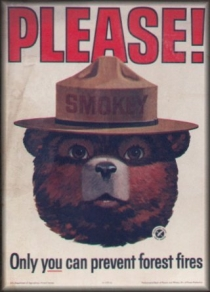
Some links might be obsolete.
Before I dig a little into this topic, a perspective and a few definitions.
Every Eastern gardener knows well how much nature wants to turn your garden into a grassy weed-patch, then into a woodland. Humans force nature to obey with great difficulty. Everyone who sanctimoniously bemoans deforestation in South America and Africa should first look out their window to see one's local deforestation.
Our Great Plains, it is believed, were at least partly the result of Indian burning practices and wildfire. And the Scottish moors? Much is the result of deforestation too, but they are beginning to re-plant. Permanent deforestation is definitely a bad thing from a conservation standpoint, but often not from a human economic standpoint. Manhattan Island is now pretty nice without the forest.
Clear-cutting, as opposed to selective logging, involves cutting almost every tree down in an area, with the intention that things will grow back. It is an efficient form of silviculture because, when the woods grow back whether re-planted or just re-seeded by Nature - most of the new trees will be ready for harvest at the same time. Unlike deforestation and selective harvesting, clear-cutting restarts the clock of natural forest succession, just as does forest fire or severe wind damage. Fire is a key to woodland health and diversity: we see the unhappy consequences of fire suppression in the West, with apocalyptic fires due to fallen dead trees rather than routine smaller fires which efficiently recycle forest litter. In an era of unnatural and probably foolish fire suppression by government (essentially a subsidization of the lumber industry and the vacation-home real estate business), only clear-cutting can imitate the normal cycle of forest succession and renewal, habitat diversity, and thus the species diversity, that conservationists seek.
(An aside on the subject of forest succession. This much-studied topic is difficult to discuss in any general way, because every habitat, region, latitude, altitude and soil has its own pattern of forest succession following disturbance. There are even areas where the normal climax forest is never achieved, as in some areas of the South where fire maintains fire-resistant pine forest in areas where deciduous trees would otherwise be the climax forest. Each stage of forest succession has specialized species which are adapted to it - and to it only. One example, from Ohio. I will need to do a piece just on the subject of forest succession, sometime.)
Which brings me to the subject of environmental concerns. I think of environmentalists as being of either the sentimental-esthetic sorts, the politically-motivated sorts, and the hard-nosed scientific sorts. This might be an unfair depiction, but I think it holds up much of the time. Mature forests are wonderfully attractive to the human eye, but, in most US ecosystems they have little biodiversity and support fewer species of plants and animals than transitional woodlands or woodland edges. Also attractive are lovely rolling green meadows, but they are about as natural as lawns, and it requires plenty of gasoline and machinery to maintain that unnaturally scenic, clean-cut condition.
The controversy, it seems to me, derives from the emotional, not the factual. It's my conclusion that clear-cutting, judiciously applied, preserving contiguous areas of mature forest and without destroying streams with erosion, best duplicates the natural condition of the life cycle of woodlands, which, in nature, are always a work in progress and never complete.
Nature is a dynamic, changing thing, but the human infestation of the planet begs for thoughtful stewardship, and sometimes that means compensating for our actions: it's our big garden, now.
Photo on top: An example of deforestation in the form of a Vermont hayfield
Photo below: Smokey the Bear, Capitalist Tool in the service of the lumber industry!




Bird Dog writing at Maggie's Farm points out the differences between deforestation and clear cutting and explains why clear cutting is a good thing. Clear-Cutting and ForestsControversy: Deforestation and Clear-Cutting in the USBefore I dig into this hot topic, a...
Tracked: Nov 09, 23:11
With all of the exciting news about wildfires, I want to make a pitch in favor of wildfire. Wildfire is natural, and it's a good thing. Fire suppression makes natural fires worse when they occur, because kindling builds up on the floor of the forests.Why
Tracked: May 14, 05:47
The Americans With No Abilities Act of 2006Clear-cutting and ConservationShelby Steele on White GuiltThe Dog's Sense of SmellThe Ruffed GrousePhoto: Name that actress
Tracked: Aug 17, 07:17
In a comment on our piece about clear-cutting, a reader let us know about this book: 1491: New Revelations about the Americas Before Columbus, by Charles Mann. Human fantasies about the Garden of Eden, like human utopian fantasies, just never give up. You
Tracked: Jun 12, 06:27